#Wright Brothers Monument
Explore tagged Tumblr posts
Text
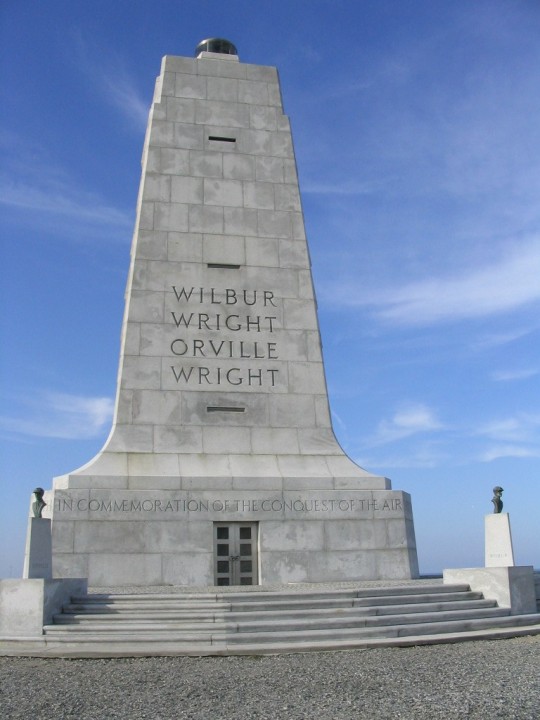
Wright Brothers National Memorial
#Wright Brothers National Memorial#Wright Brothers#Wilbur Wright#Orville Wright#Historic places#Monument#Wright Brothers Monument#Kitty Hawk#North Carolina#Kill Devil Hill#aviation history
70 notes
·
View notes
Text

Wright Brothers National Memorial
Kill Devil Hills, North Carolina
✈️
#wright brothers#orville#wilbur#kill devil hills#kitty hawk#north carolina#obx#outer banks#travel#digital nomad#flight#airplane#history#national monument#national park#national memorial
2 notes
·
View notes
Text
The Ties that (Foolishly) Bind [ @feystivus @musashi @bakedbybeanss ]

Ships: Franziska & Phoenix
Warnings: N/A
AO3 L!nk in Comments!
Franziska von Karma was fully fed up with the, frankly foolish, facade that fool, Phoenix Wright was flaunting about.
The man had been released from the hospital—a foolish decision in her opinion—and since then he had been waving off any show of worry that her brother and the detective had thrown his way. However, it was blazingly obvious that he was not fine. Not at all.
The way Phoenix hobbled about the crime scene in a slow and almost pained manor, the constant sneezing and sniffling (that was far past on her nerves), and the congested and rough voice that came out every time he spoke. ‘Fine’ wasn’t even close to being truthful. If anything, ‘disgustingly diseased’ came to her mind as she watched him fumble about.
To her dismay, she found herself shoulder to shoulder with the fool as they investigated past the bridge for more evidence. His germs much too close for comfort than she would have liked. At this closer proximity, she also noted another strange behavior of his.
As he walked and moved about, Phoenix would continuously press his hands into his back or chest. He would keep pausing as they walked to lean on anything he could find as if standing was becoming a monumental challenge.
Franziska crossed her arms as she watched the attorney. Was he honestly trying to fool her or anyone with that? She had half a mind to call Gumshoe to take him back to the hospital, or an ambulance. If only to get his sickly form out of her sight.
Phoenix let himself fall against a tree, sitting in the snow below with a loud sigh. “Gimme a second,” he huffed out at Franziska with a wave of his hand.
She walked up to look down at him. Her nose held high in her disapproving gaze. “If you are truly that sick then you are more of a hindrance in this investigation than anything else.”
Phoenix shook his head. “I’m f—”
“If you say you are ‘fine’ one more time,” she growled out. “I will whip you senseless.” She punctuated her words with a sudden crack of her whip at her side, making sure that he knew she wasn’t playing around.
Not that he ever did think that. Franziska always kept her words and promises, even the violent ones.
“It’s just a cold,” Phoenix finally huffed out in admission. He ran a hand over his face and let it fall around to the back of his neck. “It’s not that serious.”
“A cold can be very serious, Phoenix Wright,” she insisted. “And you are a fool to believe otherwise. You are clearly in far too much pain from it to even walk let alone investigate properly!”
He shook his head, pushing his arms forward and backward to stretch out his back. “It’s not that.”
“Then, pray tell, what is it?” Her arms crossed once more, still holding onto her weapon. She prepared herself for whatever foolish declaration he was about to unleash on her.
“It’s this damn binder.”
Her arms loosened only a hair.
“It’s been stupid uncomfortable since I got up here,” he sighed out in annoyance.
Franziska didn’t immediately respond. Her mind circling around the word in a frantic need to land on any sort of real thought. The first thought that finally dropped into her mind like a stone in a lake was, ‘Phoenix Wright is trans.’
It wasn’t the most fantastical observation and was quite obvious from the talk of a binder. She also could hazard a guess that it also made more sense of his nonsensical choice of name.
However, within a split second another thought forced its way into her mind. ‘Phoenix Wright is wearing a chest binder on the top of a snowy mountain while sick and exerting himself practically all day.’
Her face went hot with rage. Though, she would pause to wonder, why rage? Why had she felt so infuriated by his unhealthy choices? She hated him, didn’t she? He’d killed Prosecutor Miles Edgeworth. Ruined her life and took away her brother. Only, he didn’t. Just as he hadn’t killed Mia Fey. Just as he hadn’t ruined the life of Maya Fey or taken her sister from her.
“You absolute fool,” she spit out the word like a slur. “You are binding in this condition?!”
He looked up at her with a raised brow. “Huh—”
“Just because you are foolishly stupid does not mean you must act as such,” she interrupted him with a hiss. “Are you ill and recovering from injury! And we are higher up than you are used to being. You are already bound to be short of breath up here and binding in these conditions is downright foolish.”
Phoenix leaned fully back against the tree with a huff. He stretched his back and shoulders around, clearly trying to ease some of the tension and pain in his form. “You wouldn’t get it,” he huffed out. “It’s not just something I can not do.”
Franziska crossed her arms and turned away from the attorney. Her gaze instead floated off into the snowy distance. She momentarily mulled over her next words before speaking. Finally she said, “I do understand. I was very lucky to grow up with the father and the money I did. I never once had to use anything like that. But that does not mean I am blind to the feelings behind it or to its dangers.”
When she turned back to Phoenix, realization had flashed itself into his eyes. It was downright uncomfortable how similar the two of them really were. She really did try not to think about it. She hated to turn to her enemy and see a mirror. “I cannot tell you what to do. I am not your mother and I have no interest in acting as one, especially not with a fool like you. But if you are to be of any use to anyone, even Mis. Fey, then you must take care of yourself as well.”
Phoenix frowned and sighed. His face was twisted up in what Franziska could only guess was intense thought, even though it looked far more like constipation.
“However,” she added on. “No matter what you do, that large coat of yours I’m sure will continue to make you look like a foolish fridge of a man.” She waved her hand dismissively before turning her back to Phoenix once more. Whatever he chose to do with her words was none of her business or interest.
After a few minutes Phoenix was back at her side with another good stretch of his limbs. She didn’t wait long before she started walking again and expected him to follow.
“So you’re also…”
“Yes,” she confirmed with a curt nod.
Phoenix let out a light chuckle. “Sounds like the two of us have more in common than I thought.”
Franziska was quick to crack her whip out at the man’s feet. He responded with a loud sound of surprise. “Shut your foolishly foolish mouth, Phoenix Wright.”
#ace attorney#franziska von karma#phoenix wright#worsties in law#fan fic#fan fiction#writing#toonz writing
3 notes
·
View notes
Text
10 Fascinating Facts About Aviation You Didn't Know
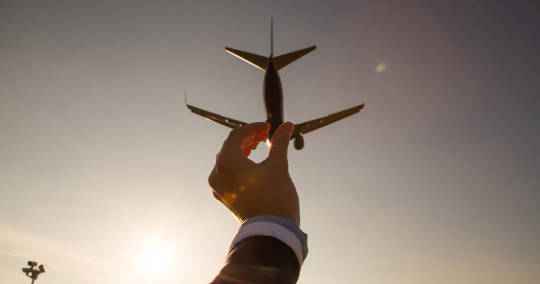
Aviation has always been a field filled with wonder and discovery. From the early days of flight to the advanced technology we see today, aviation continues to captivate our imagination. Whether you're an aviation enthusiast, a frequent flyer, or someone simply interested in how airplanes work, there are many fascinating facts that might surprise you. In this blog post, we'll explore ten intriguing facts about aviation, shedding light on the remarkable history, technology, and people behind the scenes.
1. The Wright Brothers' Historic Flight
Most people know that Orville and Wilbur Wright made the first powered flight in 1903, but what many don’t realize is that it lasted only 12 seconds and covered just 120 feet. This monumental achievement in Kitty Hawk, North Carolina, was the beginning of human flight, paving the way for the aviation industry as we know it today.
2. The Largest Passenger Aircraft
The Airbus A380 holds the title of the largest passenger aircraft in the world. It can carry up to 850 passengers in an all-economy configuration and typically features two full-length passenger decks. Its massive size and advanced technology make it a marvel of modern engineering, demonstrating just how far aviation has come since the Wright brothers’ era.
3. The World’s First Commercial Flight
The world’s first commercial airline flight took place on January 1, 1914. The St. Petersburg-Tampa Airboat Line flew a route across Tampa Bay, Florida, with a fare of $5, which is equivalent to about $150 today. This flight marked the beginning of a new era in transportation, setting the stage for commercial aviation to become a global phenomenon.
4. Air Traffic Control
The concept of air traffic control was born in the 1920s. The first air traffic control tower was established at Cleveland Hopkins International Airport in 1930. Today, air traffic controllers play a crucial role in ensuring the safety and efficiency of air travel, managing thousands of flights daily across the globe.
5. The Invention of the Black Box
The black box, formally known as the flight data recorder (FDR) and cockpit voice recorder (CVR), was invented in the 1950s. This device records critical flight information and cockpit conversations, helping investigators understand the causes of accidents. Interestingly, the black box is not actually black; it’s bright orange to make it easier to locate after an incident.
6. Aviation Fuel Efficiency
Modern aircraft are much more fuel-efficient than their predecessors. For instance, the Boeing 787 Dreamliner is designed to use 20% less fuel than older models. This improvement is achieved through advanced materials and technologies that optimize aerodynamics and reduce weight. As the aviation industry continues to innovate, we can expect even more significant advancements in fuel efficiency.
7. The Role of Flight Attendants
Flight attendants are often seen as the friendly faces of an airline, but their job goes far beyond serving snacks and drinks. They are trained to handle emergencies, provide first aid, and ensure passenger safety. Their role is vital, as they are the first line of defense in ensuring that flights operate smoothly and safely.
8. Airplanes Are Equipped to Fly Without Pilots
While it might sound like science fiction, many modern airplanes have sophisticated autopilot systems that can fly the aircraft without human intervention. These systems can handle everything from takeoff to landing, though pilots remain crucial for monitoring and controlling the aircraft. The advancements in automation have made air travel safer and more efficient.
9. The Effect of Weather on Aviation
Weather plays a significant role in aviation safety and operations. Pilots must be aware of various weather conditions, such as turbulence, thunderstorms, and fog. For example, thunderstorms can create severe turbulence and lightning hazards, leading to flight delays or diversions. Understanding weather patterns is an essential skill for pilots and air traffic controllers alike.
10. The Future of Aviation
The future of aviation is promising, with advancements in technology leading to the development of electric and hybrid aircraft. Companies are investing in research and development to create eco-friendly planes that reduce carbon emissions. As global awareness of climate change grows, the aviation industry is working to adapt and innovate to meet environmental challenges.
Conclusion
Aviation is a field rich with history, innovation, and incredible achievements. From the first powered flight to the complexities of modern air travel, the evolution of aviation has been nothing short of extraordinary. At Airwing Aviation Academy, we believe in sharing this passion for aviation with aspiring pilots and aviation professionals. By providing comprehensive training and education, we aim to inspire the next generation of aviators.
Whether you're looking to become a pilot, a flight attendant, or simply interested in learning more about the aviation industry, we invite you to explore the possibilities. With our expert instructors and state-of-the-art facilities, the Aviation Academy in Udaipur is the perfect place to launch your career in aviation.
Understanding these fascinating facts about aviation can enhance your appreciation for this remarkable industry. As we look to the future, it’s exciting to think about what new discoveries await us in the world of flight.
2 notes
·
View notes
Text
It's Hatteras, not Hatteras
Drive day number 3 is brought to you by Blake.
As the nights go by, the accommodations have fewer and fewer beds, and we become cozier by the day. Come morning, The hotel provides a hot Breakfast of folded eggs with american cheese, meat circles and coffee as thick as the air. Derek ate his breakfast in a daze, and we hit the road with full bellies and high hopes.
A brief stop into traders J's for road snacks is an air conditioned paradise. Walking out with a heavy bag of groceries makes us feel like kings. We are kids in a candy store, swapping treasures in the haven of the van.
Early on we pass large coal mounds and massive cranes as we near the Atlantic. Joel and Derek debate the psychologic vs physiologic aspects of the massive underwater tunnel transporting us beneath the bay.
Crossing into north Carolina we see a cyber truck, and are enthralled at the heavily innuendoed road signs. We opt out of getting crabs from dirty dick's. You're welcome ladies.
The southern sun beats down all around, and we are eternally grateful for the AC of our zippy minivan. Roadside monster truck tracks and impressive mini golf courses beckon us to challenge the heat, but level heads prevail until unskippable history spurs us to embrace the sun. The Wright brothers national monument consists of a beautiful open field leading to a manicured hill and spire. At $10 a head, we are forced to rival the brothers in their imagination, say hello to the park employee, and promptly turn around and skip it.
Cornfields and acreages give way to sand dunes and stilted houses. We drive over the long and curved Bonner bridge (heh) leading us to pea island (hehe).
There are many turnoffs to enjoy the national treasure of the outer banks, all of which are sudden and unexpected, leaving us to admire the ocean from a distance until at long last we reach our campsite. Tent be damned, we stroll to the beach and firmly plant ourselves on the sand. Armed with our own delicatessen, we rip the bread apart, Dylan and Derek doling out meat cheese and greens. Dinner is dry and delicious. Joel asks us to let him die happily on the coast, and Allen admires the mussels percolating through the surf.
Eventually the tent is set up with tired gutso, using pieces salvaged from Dylans duffel, and lashed to the roots of the bushes that surround us. Laughs are had over the picnic bench, until a tick frightens us into the tent. The stars beam as Derek reads us lullabies of poop and stool, and the cicadas chirp their final goodnight.
(Blake)
3 notes
·
View notes
Text
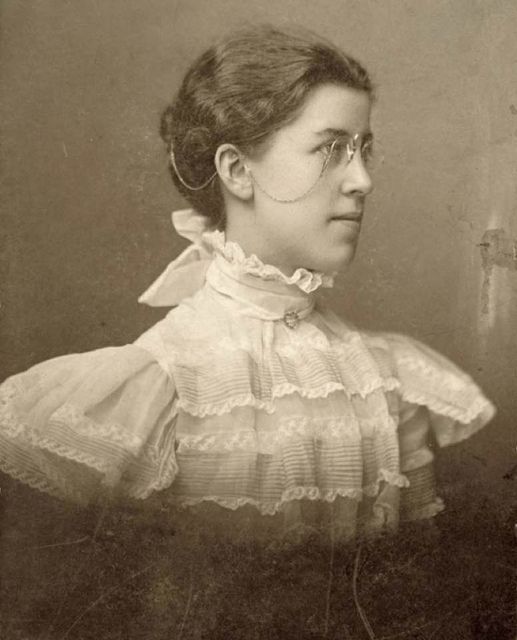
Katharine Wright, often overshadowed by her famous brothers Orville and Wilbur, played a pivotal role in ensuring the success of the Wright Brothers' historic achievements in aviation. Her contributions, though sometimes overlooked, were instrumental in shaping the course of history.
She provided crucial financial support to her brothers' endeavors. She managed the household affairs, allowing Wilbur and Orville to focus on their experiments and research. She even took on additional work to supplement their income, demonstrating her unwavering dedication to their vision.
Beyond financial assistance, Katharine offered unwavering emotional and moral support to her brothers. She believed wholeheartedly in their ambitions, encouraging them during moments of doubt and celebrating their triumphs. Her belief in their abilities bolstered their confidence and determination, essential qualities for tackling the monumental challenges they faced.
Katharine possessed a keen intellect and a sharp understanding of business and public relations. She provided strategic advice to her brothers, guiding them in their interactions with investors, government officials, and the media. Her diplomatic skills and foresight helped navigate the complexities of the aviation industry, paving the way for the Wright Brothers' success.
She also took on the role of public relations manager for the Wright Brothers, actively promoting their achievements and garnering support for their endeavors. She engaged with #journalists, #politicians, and influential figures, effectively shaping the public perception of her brothers' work. Her advocacy efforts helped garner widespread recognition and acclaim for the Wright Brothers' groundbreaking achievements.
Katharine herself was well-educated and intellectually curious. She shared her knowledge and insights with her brothers, enriching their understanding of various subjects relevant to their work, including #aerodynamics and #engineering principles.
Her intellectual contributions complemented her brothers' technical expertise, resulting in a more holistic approach to their research and experimentation.
3 notes
·
View notes
Text
The Wright Brothers' Museum
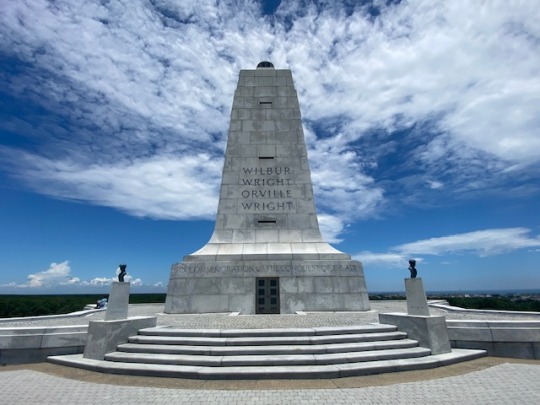
Our first day and it had to be spent at this special place - The Wright Brothers' Museum. We cycled to the place, which was a simple five mile cycle. It was a scorching day as we made our way up to the monument. This stands at the top of the hill that the brothers used to launch their early flights - not the successful ones though. They were actually launched from the flat ground.
We walked along the ground where the first flight occurred. The stone boulders show the distance that each flight made. The third flight was much longer than the first two. We didn't walk out to the last one, but it was great to just stand in the place that history was made.
It's remarkable to think of how this piece of history impacted the world. My love of travel does not include a love of flying, nevertheless without it, I would never have been able to see the wonderful sights in all the countries I've visited. The determination, hard work, creativity and vision of the two brothers has been an inspiration to so many and the museum brings it to life.
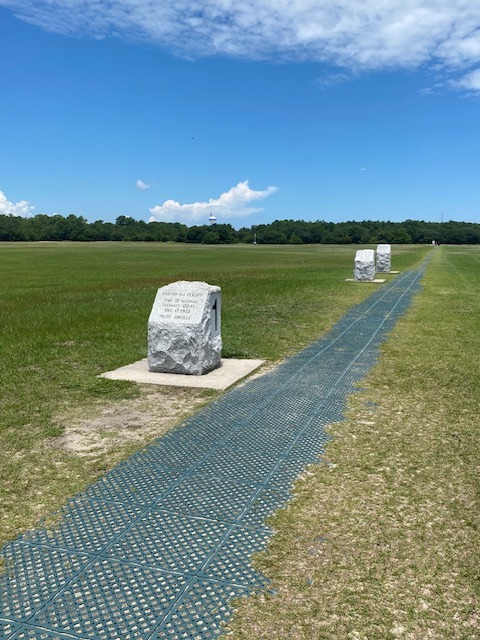

2 notes
·
View notes
Text
GAVE MY BROTHER MY FLIP PHONE AND IN HEAVEN HOUDIN. FEET WHITE COMING UNDER MY FEET KNOW SMARTPHONE WHEN I HANDED HIM MY FLIP PHONE BEFORE SMARTPHONES WERE BUILT; IN THE MASTER BEDROOM MONSTERS IN MY HEATER john wright follows Gabby as her body guard and wants that person so she coud be a bergenfield police officer he locks himself in the monument of Palisades Ave in Englewood NJ in a tunnel; won't let me leave stop and go I'm already in hackensack corner store he's bugging that I was left in the car my brother shook never going to be John wrights hand in my head;
0 notes
Text
The Wright Brothers Memorial: Birthplace of Flight
Standing at the base of the Wright Brothers Monument, where the dream of flight became reality! Location: Wright Brothers National Memorial – National Park Service, 1000 N Croatan Hwy, Kill Devil Hills, Outer Banks, North Carolina, USA. Time and Date: Around 1:30 pm on Jan 1st, 2025.
#Currituck Beach Lighthouse#Hegde Travel Photos#Historic Corolla Park#North Carolina#Outer Banks#The Wright Brothers Memorial#Travel Explore Enjoy
0 notes
Text
Best Things to Do in Washington, DC, with Kids: Family-Friendly Activities
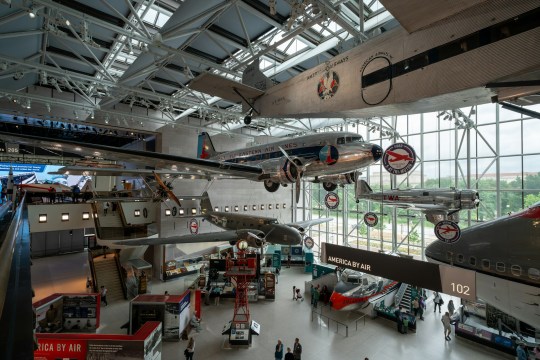
Credit: Image by Tomasz Zielonka | Unsplash
Top 5 Must-Try Things to Do in Washington, DC, with Kids
Washington, DC, is so much more than the capital of the United States; it has a lot of history and fun and is a perfect destination for families with kids. It may surprise parents that there are many fun things for children to do in the capital. Here are five must-try things to do in Washington, DC, with kids, ranging from museums to outdoor experiences.
1. Visit the Smithsonian National Air and Space Museum
One of the best things to do with kids in Washington, DC, is visiting the Smithsonian National Air and Space Museum. This museum is one of the many things that families should not miss out on. It showcases some of the most recognizable relics of aviators' history, such as the Wright Brothers' Flyer and the Apollo Mission Module.
Children will not want to leave the "How Things Fly" gallery, which is designed as an entertaining way to engage children with scientific principles of flight. If you are a little older, the museum has exciting opportunities to fly a spacecraft or a jet through the flight simulators.
It also has an IMAX theater where families can watch interesting movies about space and the natural world. Taking in an oldie-but-goodie at the cinema is the best—or the cheapest—way to do it: Admission is free!
It is suggested that children visit the places ahead of time without crowds; the walking tour helps them navigate the National Mall when they get tired and need to jump freely, taking in fresh air.
2. Explore the National Zoo
Another family attraction in DC worth mentioning is the Smithsonian National Zoo. One of the world's largest and most famous conservation organizations, this zoo hosts 2,700 animals from 396 species.
Kids would particularly love this zoo because the giant panda village is a frequent stopover. The Kids' Farm lets children get up close to tractors and interact with animals on the farm, while the Amazonia will give families the much-needed feel of the rainforest involving sloths and piranhas.
When you want to spend most of the day outside, the National Zoo is a suitable venue since the entrance fee is free. Remember to bring some food and drinks with you since the zoo is expensive and requires a lot of walking. It is essential to read the information on the map before visiting so that tourists can assess the time they will spend sightseeing.
3. Take a Ride on the DC Circulator to Explore Monuments
Visiting famous monuments in DC is also mandatory when traveling with the kids, and taking the Circulator bus is fun for everybody. This cost-effective guided shuttle tour covers all main attractions, including the Lincoln Memorial, Washington Monument, and Martin Luther King Jr. Memorial.
Children will see the Statue of Freedom at the Lincoln Memorial and study more about Civil Rights through the quotes found at the monument for Martin Luther King Jr.
The National Mall route is incredibly comfortable for families because the stops are planned near numerous attractions. Carry comfortable shoes, especially for moving around between stops, and carry food for a mini picnic at any open Mall area.
4. Discover the International Spy Museum
If one wishes to get some thrill, no one can beat the International Spy Museum. The programs and most of this museum's exhibits are based on performing secret missions and using authentic spy equipment. One of the museum's main focus activities is Operation Spy, where the children must become secret spies and complete different tasks.
Even children will find it very interesting and informational, from button cameras to disguise kits and other spy tools that are exhibited there.
Kids between 7 years and above will enjoy games such as code-solving and functioning as spies for this museum. Tickets may not be free, but the only way to avoid long queues is to prepare in advance and book this ticket online.
5. Enjoy Outdoor Fun at the National Arboretum
National Arboretum is excellent for families who wish to spend their time away from the noise and crowds of the city staying in a vast territory. Spread across dozens of acres and accessible via a car or public transportation, this place is perfect for a family picnic.
There are designated walking paths, beautiful gardens, and photographed spots like the Capitol Columns. The Children's Garden offers an opportunity to learn about plants and gardening, mainly through direct experience.
They are entirely suitable for children's play while allowing them to tour the region's natural landscape, as in the case of the arboretum. Events like visiting the beautiful cherry blossoms or learning to plant one's garden during the right season add value.
This means there are so many things to see; therefore, you should plan your trip and the areas you wish to take your kids to so they won't get too bored.
Tips for Visiting Washington, DC, with Kids
When planning a family trip to Washington, DC, keeping the kids comfortable and engaged is essential. Here are some tips to ensure a smooth experience:
Choose Public Transportation
Washington, DC, is best navigated using the Metro and DC Circulator buses. These are cost-effective and convenient ways to hop between the city’s numerous attractions.
Pack Snacks and Water
Kids need regular snacks and hydration, especially when walking around and exploring all day. Pack light, healthy snacks like fruits, granola bars, and water bottles to keep their energy up without needing frequent stops.
Plan for Breaks
Sightseeing can be exhausting for young children. Plan your itinerary with plenty of short breaks at parks, cafes, or even resting spots near major landmarks where they can relax.
Visit Kid-Friendly Attractions
DC has numerous great attractions for kids, including the National Zoo, the Smithsonian National Museum of Natural History, and the National Air and Space Museum. These places are not only educational but also very engaging for young minds.
Stay Nearby
Consider booking accommodation close to the areas with the most attractions you plan to visit. This reduces transit time and gives you a quick fallback option for naps or unexpected needs.
It also helps to remain as close to the National Mall as possible to minimize traveling time.
That is why a family interested in spending their vacation enjoying and exploring exciting and entertaining activities will have ample substance in Washington, DC.
There's fun from the Smithsonian Museum complex, with hundreds of exhibits and collections, down to the rolling greens of the National Arboretum. These five must-do activities guarantee kids and parents the best time and learning fun in one of the greatest cities on earth.
Check our website at https://dcmetrocondos.com/washington-dc-things-to-do/ for more on the area.
Discover different things to do in Washington, DC with kids! Check out our guide to family-friendly attractions, events, and outdoor activities.
#Community Information#Real Estate#Real Estate Blogs#Homes for Sale#Washington DC Real Estate#Washington DC Realtor#Washington DC Homes#Washington DC Neighborhoods#Washington DC Communities#Washington DC travel#Best attractions in DC#Things to do in Washington DC#DC sightseeing guide#Family activities in DC#Historic landmarks in DC#National Mall highlights#Free attractions in Washington DC#DC museums and culture#Travel tips for Washington DC
0 notes
Text
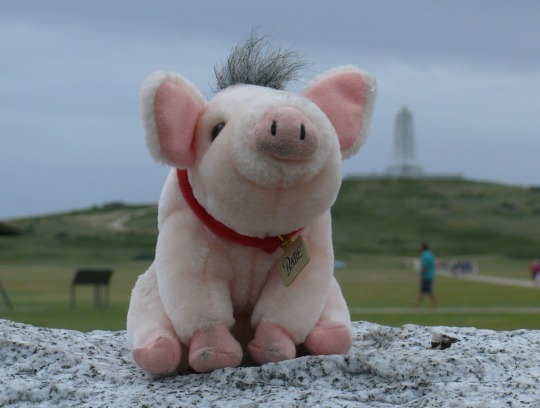
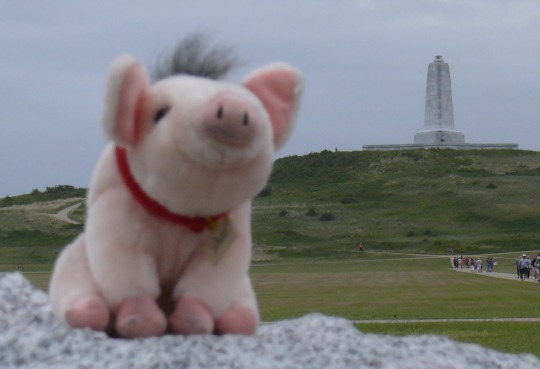
A Little Pig Goes A Long Way... Babe the pig at Wright Brothers Monument, Kitty Hawk, NC
0 notes
Text

Name: Damon Logano
Age: 29
Gender: Male
Sexuality: Gay
Race: Human
Appearance: Short black hair, dark green eyes, average height and build, usually wears dark eyeliner, has several piercings.
FC: Michael Christopher Bolten (specifically from his appearance on Criminal Minds)
Personality: Sarcastic, efficient, charismatic, funny, intelligent, great at social engineering, explosive temper that he tries hard to keep in check, morbidly creative with his threats and insults, driven, strong sense of justice, outgoing, private.
Powers/Abilities: After the incident with Scarecrow, he became mostly immune to fear toxin, and developed shadowmancy, the ability to create illusions and/or weapons out of shadows. He also has heightened senses and insight into the fears of those around him.
Flaws/Weaknesses: Human mortality, anger management, doesn’t think highly of himself outside of what he can do for others.
Nationality: American
Languages: English
Education: Bachelor’s degree in Sociology
Style: Goth/punk outside of work, but he dresses much snappier while on the clock, especially when attending big events or press conferences. Either way, he wears a lot of black, gray, and purple.
Profession: publicist for Bruce Wayne (v; main 1), antihero known as Shadowhaunt (v; main 2), Scarecrow’s right hand man (v; villain arc)
Family: Grayson Logano (father, estranged), Emily Logano neé Price (mother, deceased), Addy Wright-Logano (stepmother, estranged), Drake Logano (younger brother), Mina Logano-Wright (younger half-sister)
Backstory:
Damon was born in Ireland to Grayson and Emily Logano, a promising couple of young engineers who’d just gotten married a year prior. Four years later, Drake was born, and three years after that, the family moved to Gotham, New York, as Grayson had managed to land a high paying job at Wayne Enterprises. It was a tough adjustment, but they got through it as a family. Emily, however, fell ill not long afterward, and passed away when Damon was only thirteen.
To the shock and dismay of his sons, Grayson barely waited a month after the funeral to remarry, causing a rift between him and Damon. Said rift only grew bigger when Damon found out that his new stepmother had been his father’s longtime mistress, and that he was only marrying her now because she was pregnant with his daughter. Tensions ran high, especially with Damon about to start high school. Neither of the boys were on good terms with their father, nor were they particularly fond of their stepmother, but Damon at least tried to be a good big brother when Mina was born. She was completely innocent, after all, not to mention the apple of Grayson’s eye.
Despite their father’s blatant favoritism toward Mina and their stepmother’s love of extravagance, the three siblings remained close as they grew older, always looking out for each other. Damon hated the thought of leaving them behind after graduation, so he stayed in Gotham for college. It was while he was studying for his bachelor’s degree that he finally properly met the young playboy Bruce Wayne, whom he quickly befriended after seeing right through the man’s façade. The two became thick as thieves, with Damon fearlessly fending off paparazzi and sleazy reporters on his behalf. It was this behavior and his expertise with social media that landed him the job as Bruce’s publicist after he graduated college.
Damon’s work ethic was impeccable and he grew bolder as the years went on. Unfortunately, his relationship with his father and stepmother declined even further, as both of them were jealous of his success and kept trying to tear him down. He cut contact with them after his father reached out to Bruce and tried to get him fired, but by then, the damage to his psyche was monumental. His depression and anxiety were worse than they had ever been, resulting in destructive outbursts due to his already prominent anger issues. Not wanting to end up hurting anyone, he began seeking out psychiatric help, had trouble finding a therapist who was accepting of him. He refused to let that hold him back, though, and kept trying.
Bruce knew almost none of this. Damon didn’t want his friend and employer to worry about his mental state, fearing that Bruce might fire him if he found out how unstable the publicist was. He kept it hidden for years.
Things came to a head when the Scarecrow went on another rampage through Gotham. Damon had the misfortune of being in his warpath, and was taken hostage after being dosed with fear toxin, dragged off to the old ACE Chemicals facility. However, he became far more violent than Scarecrow anticipated, rage bursting forth in tandem with his terror. He fought tooth and nail to free himself from both the villain’s clutches and the horrific hallucinations, spewing curses, insults, and threats the entire time. Batman followed them, of course, and engaged Scarecrow in battle, not realizing that some of the vats in the facility had not been drained. At some point during the fight, Damon fell into one, and was forever changed. The fear toxin in his bloodstream mixed with the mutagenic chemical in the vat and his own adrenaline to give him superpowers, nearly killing him in the process. He awoke in the hospital a week later with his clearly exhausted siblings watching over him.
It took him a while to recover physically, and even longer to recover mentally and emotionally, but when he did, he was livid. With Scarecrow, with Batman, with ACE Chemicals, and with himself for getting caught in the first place. Punching a mirror in frustration led him to discover his new shadowmancy powers, and he began to experiment with them and test his limits. Eventually, he gained enough courage and confidence to go back to work, which Bruce was thrilled about. The man had been checking in on him almost as often as Drake and Mina after the accident, and was glad to see his friend back on his feet. After dark, Damon took to the streets as the ruthless and ethereal Shadowhaunt, making Gotham’s villains regret their life choices in increasingly morbid and creative ways. He declared Scarecrow as his archenemy, of course, but also had a particularly violent hatred for the Joker.
#📱 personnel file 📱 about#📱 world’s best publicist 📱 v; main 1#📱 your worst nightmare 📱 v; main 2#📱 off the clock 📱 ooc talk
1 note
·
View note
Text
Events 7.14 (after 1900)
1900 – Armies of the Eight-Nation Alliance capture Tientsin during the Boxer Rebellion. 1902 – Peruvian explorer and farmer Agustín Lizárraga discovers Machu Picchu, the "Lost City of the Incas". 1902 – The Campanile in St Mark's Square, Venice collapses, also demolishing the loggetta. 1911 – Harry Atwood, an exhibition pilot for the Wright brothers, is greeted by President Taft after he lands his aeroplane on the South Lawn of the White House, having flown from Boston. 1915 – Beginning of the McMahon–Hussein Correspondence between Hussein bin Ali, Sharif of Mecca and the British official Henry McMahon concerning the Arab Revolt against the Ottoman Empire. 1916 – Battle of Delville Wood begins as an action within the Battle of the Somme, lasting until 3 September 1916. 1933 – In a decree called the Gleichschaltung, Adolf Hitler abolishes all German political parties except the Nazis. 1933 – Nazi eugenics programme begins with the proclamation of the Law for the Prevention of Hereditarily Diseased Offspring requiring the compulsory sterilization of any citizen who suffers from alleged genetic disorders. 1942 – In the Wardha session of Congress, the "Quit India" resolution is approved, authorising Mahatma Gandhi to campaign for India's independence from Britain. 1943 – In Diamond, Missouri, the George Washington Carver National Monument becomes the first United States National Monument in honor of an African American. 1948 – Palmiro Togliatti, leader of the Italian Communist Party, is shot and wounded near the Italian Parliament. 1950 – Korean War: beginning of the Battle of Taejon. 1951 – Ferrari take their first Formula One grand prix victory at the British Grand Prix at Silverstone. 1957 – Rawya Ateya takes her seat in the National Assembly of Egypt, thereby becoming the first female parliamentarian in the Arab world. 1958 – In the 14 July Revolution in Iraq, the monarchy is overthrown by popular forces led by Abd al-Karim Qasim, who becomes the nation's new leader. 1960 – Jane Goodall arrives at the Gombe Stream Reserve in present-day Tanzania to begin her study of chimpanzees in the wild. 1960 – Northwest Orient Airlines Flight 1-11 ditches off Polillo Island in the Philippines, killing one person and injuring 44. 1965 – Mariner 4 flyby of Mars takes the first close-up photos of another planet. The photographs take approximately six hours to be transmitted back to Earth. 1983 – Mario Bros. is released in Japan, beginning the popular Super Mario Bros franchise. 2002 – French president Jacques Chirac escapes an assassination attempt from Maxime Brunerie during a Bastille Day parade at Champs-Élysées. 2013 – Dedication of statue of Rachel Carson, a sculpture named for the environmentalist, in Woods Hole, Massachusetts. 2015 – NASA's New Horizons probe performs the first flyby of Pluto, and thus completes the initial survey of the Solar System. 2016 – A man ploughs a truck into a Bastille Day celebration in Nice, France, killing 86 people and injuring another 434 before being shot by police.
0 notes
Text
Schools should teach that America is exceptional—not because Americans are better people than others—but because we have set up a system of rights that, over time, have become available to people who come to this country from all parts of the world. To get at the core of American identity, students should ask: if a foreign country invaded the United States, what monuments and artifacts would be most important to try to preserve because they go to the essence of what it means to be an American? For me personally, the most important monuments to our nation’s values start with the National Archives, home of the essential documents of our liberal democracy—the Declaration of Independence, the U.S. Constitution, and the Emancipation Proclamation. I would also include the Statue of Liberty, symbolizing America’s openness to legal immigrants from across the world no matter their racial or ethnic origin. And I would want to protect from attack the memorials to Abraham Lincoln and Martin Luther King, Jr., who helped America live up to its declared values, and would encourage people to see the Wright Brothers National Memorial in North Carolina, a symbol of American ingenuity and free enterprise. The lessons in the textbooks will only take firm hold if they are reinforced by the daily experience of students. To maintain social cohesion, and underline democracy’s message that we all have equal rights, officials should take strong steps to bring children of different racial, ethnic and economic backgrounds together to learn—not through compulsory busing but through public school choice and housing policy. Community service programs in school and national service programs after high school graduation should be used to bridge divides and ignite patriotic sentiments. The federal government can support these various policies through a race to the top program to sustain promising practices centered around teaching balanced history and civics education, and promoting school integration, and community service. The stakes of teaching American identity are enormous. Human beings have a natural yearning to identify with groups that pursue a larger purpose. If educators don’t help students develop a reflective patriotism, extremists will offer false alternatives centered around race or ethnic identities. The good news is that the public supports a better path. Instilling a renewed sense of American identity could inspire a “patriotism dividend,” a strong sense of national community that has provided the precondition for all this country’s great movements for social change over time. Best of all, it could help put America on better footing to sustain its grand experiment in liberal democratic governance for another 250 years—a worthy goal to ponder this July 4th holiday.
0 notes
Text
Galata Tower: A Beacon of Istanbul's Rich Heritage and Architectural Grandeur
The Galata Tower, an iconic historical monument in Istanbul, Turkey, stands as a testament to the city's rich and diverse cultural heritage. Known locally as Galata Kulesi, this medieval stone tower dominates the skyline of the Galata district, offering panoramic views of Istanbul's enchanting landscape, including the Bosphorus, the Golden Horn, and the sprawling metropolis that bridges Europe and Asia.
The tower's history dates back to the 14th century, when it was constructed by the Genoese colony in Constantinople, which is modern-day Istanbul. The Genoese, who were powerful maritime traders, built the tower as part of their fortified district of Galata in 1348 during the reign of the Byzantine Emperor John VI Cantacuzene. Initially known as the Christea Turris, or the Tower of Christ, the Galata Tower was primarily intended for defense and surveillance, overseeing the bustling activities of the Golden Horn.
Standing at approximately 67 meters (220 feet) in height, the Galata Tower was the tallest structure in Istanbul when it was built. Its cylindrical structure, made of stone, has withstood centuries of seismic activity, wars, and numerous reconstructions, attesting to the architectural ingenuity of its builders. The tower's robust design features an exterior of sturdy masonry, topped with a conical cap that enhances its distinctive silhouette against the city's skyline.
Throughout its history, the Galata Tower has served various purposes beyond its original defensive role. During the Ottoman period, it functioned as a fire-watch tower, a crucial role in a city where wooden structures were prone to devastating fires. The tower's strategic vantage point allowed early detection of fires, contributing significantly to urban safety.
One of the most fascinating episodes in the tower's history involves the legendary flight of Hezarfen Ahmed Çelebi in the 17th century. According to Ottoman chroniclers, Hezarfen Ahmed Çelebi, an early aviation pioneer, used artificial wings to glide from the Galata Tower across the Bosphorus to the Üsküdar district on the Asian side. This remarkable feat, if true, would make him one of the first humans to achieve controlled flight, predating the Wright brothers by centuries. This story has become an integral part of the tower's folklore, illustrating the blend of history and legend that surrounds the Galata Tower.
In the modern era, the Galata Tower has been transformed into a popular tourist attraction. Visitors can ascend the tower via an elevator, followed by a short staircase, to reach the observation deck. From this vantage point, they are treated to a breathtaking 360-degree view of Istanbul's diverse and vibrant cityscape, encompassing historic sites like the Hagia Sophia, the Blue Mosque, and the Topkapi Palace, as well as the serene waters of the Bosphorus.
Inside the tower, various floors house a museum that showcases its storied past through exhibits of artifacts, historical documents, and multimedia displays. The tower also features a restaurant and a café, where guests can enjoy traditional Turkish cuisine while soaking in the magnificent views. In the evening, the tower is often illuminated, adding a magical ambiance to its already captivating presence.
The Galata Tower is more than just an architectural landmark; it is a symbol of Istanbul's enduring legacy as a crossroads of civilizations. Its enduring presence through centuries of change reflects the city's resilience and its ability to blend the old with the new. Today, the Galata Tower continues to draw visitors from around the world, standing as a beacon of Istanbul's historical grandeur and its vibrant, ever-evolving culture.
0 notes
Text
youtube
Unlock the power of Napoleon Hill's ninth principle, the Power of the Master Mind, in this inspiring video from Douglas Vandergraph. Learn how the Wright brothers and Apple Inc. harnessed this principle to achieve monumental success. Discover practical steps to create your own Master Mind group and propel your goals to new heights. Douglas is putting himself out there as an example to others so they can see how anyone can take a chance, improve daily, and make a difference in the lives of others. What is it that you want in your life? Douglas can show you how to get it! Douglas is completing this free daily video series in the hopes he can help just one person.
#MasterMind #SuccessPrinciples #ThinkAndGrowRich #BusinessGrowth #PersonalDevelopment
#napoleonhills13principles#napoleonhill#mastermind#youtube#motivation#success#success story#successful#successstories#motivationalspeaker#motivationalstory#inspirationalstory#motivateyourself
0 notes